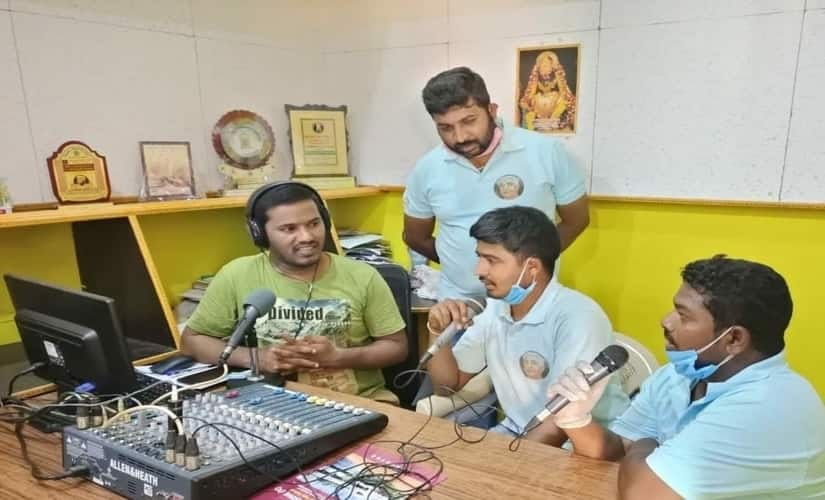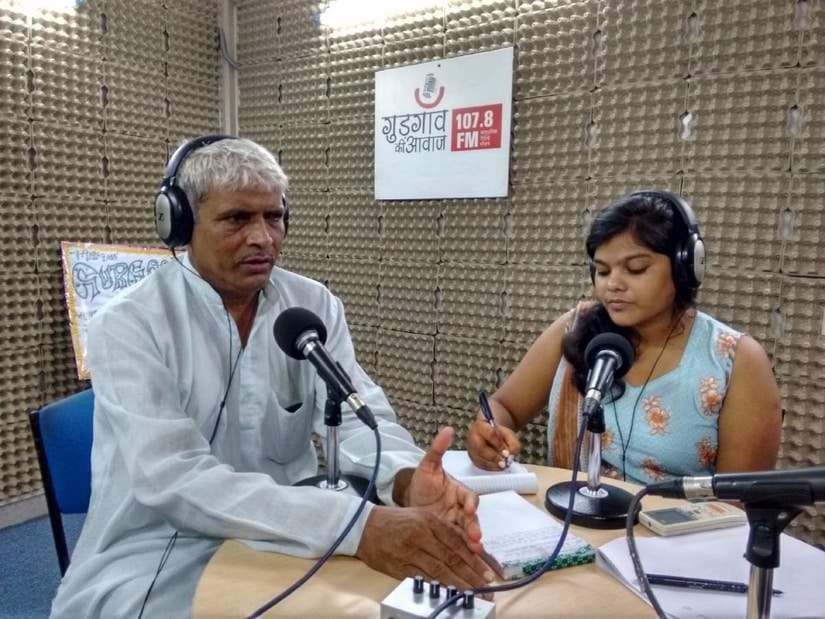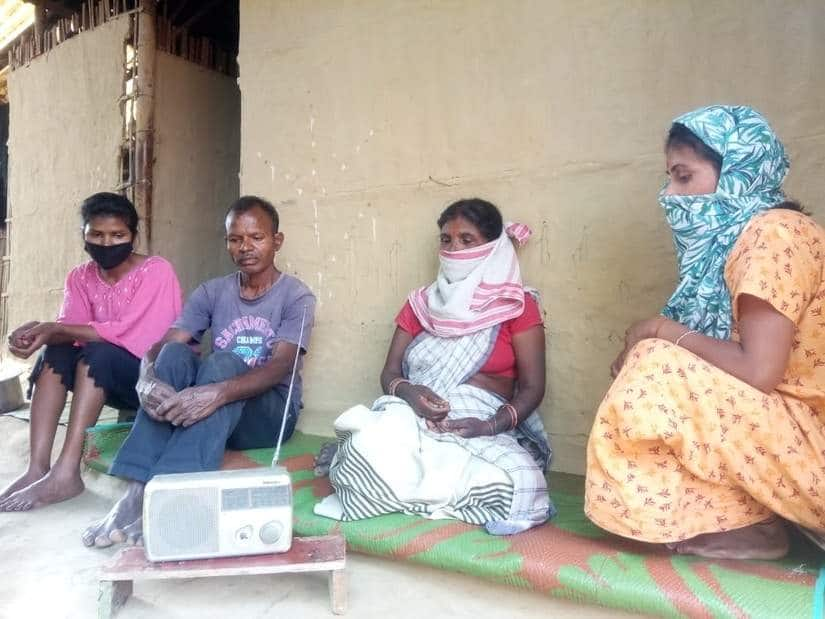With the poor presence of mainstream media in rural parts of India, the community radio stations have become a lifeline for not just the government, but also for the people. Especially when the entire country is under lockdown due to coronavirus, these stations help identify local concerns. “Community radio programmes are made with partnership and participation of community members. The programmes are usually done in local languages and dialects. All of these features have made community radio a very significant medium during a crisis like this,” said Vinod Pavarala, a professor in the Department of Communication, University of Hyderabad. Pavarala is also the founder president of the Community Radio Forum–India and leads the UNESCO Chair on Community Media. As per government guidelines, the transmission range of a community radio centre, which is essentially a low power FM radio station, is between 10-15 kilometres with a 100 ERP (Effective Radiated Power) transmitter. For a community radio station, the use of a 50-watt 100 ERP transmitter is allowed. Mostly associated in the dissemination of agriculture-related information and government welfare schemes, more than 260 radio stations across India offer the “marginalised communities a platform to make their voice heard and an opportunity to express their views”. These radio stations act as essential communication channels for enhancing the last mile outreach of the government. The Community Radio Facilitation Centre of the Ministry of Information and Broadcasting describes community radio as an effective tool to achieve plurality in media by ensuring participation of marginalised sections to address information poverty. Despite a favourable judgment by the Supreme Court of India in February 1995, the attempt to popularise the concept of community radio actually started in December 2002, when the Government of India formulated a policy to grant licenses to well-established educational institutions, including IITs/IIMs, for setting up of Community Radio Stations. According to Aaditeshwar Seth of Gram Vaani Community Media, “Until late 2006, only educational institutions were allowed to set up campus radio stations.” In many parts of India, radio is the primary source of news and entertainment. All India Radio, as the public service broadcaster, forms the top tier of radio coverage in the country. Commercial enterprises like the private FM radio forms the second tier while community radio services, which are closest to the grassroots, comprise the third tier. Apart from disseminating knowledge among the local communities and bridging the gap between the government and marginalised population, these radio stations also play a critical role in disaster management. A year after the devastating Uttarakhand floods in 2015, six community radio stations in the state were brought under one umbrella to educate people on environmental conservation and dangers of unplanned development. In the health sector, community radios serve to address local health concerns while educating the marginalised sections on the prevention of diseases like HIV/AIDS, TB, malaria, encephalitis, among others. Even during the coronavirus pandemic, the community radios are on the forefront in remote pockets educating listeners on different protocols to be followed. Had it not been for the intervention and proactiveness of the community radio stations across India, the COVID-19 crises would have exploded in rural India.
Role during COVID-19 crisis
When the news first trickled out of Wuhan in China’s Hubei province about an epidemic, the warning bells rang in India as well. On 30 January, Kerala, a state that had already battled Chikungunya and Nipah virus and lived through a devastating flood, got India’s first COVID-19 case. The state was quick to prepare itself. “We stopped all other programmes and sent broadcast messages from the district collector, superintendent of police, chief minister, health minister and officials from other departments. We broadcasted more than 50 public service announcements. Every day we broadcast coronavirus related programmes for more than seven hours,” said Father Bijo Thomas Karukappally, who is the station head of Radio Mattoli, run by Wayanad Social Service Society in Kerala. Apart from police and health officials, Radio Mattoli also invited officials from the state’s agriculture department to interact with its listeners. For Bhaskar Jyoti Bhuyan, who is the station head of Radio Brahmaputra in Maijan Borsaikia village from Assam’s Dibrugarh district, programmes on COVID-19 were now a priority. “We give information on COVID-19 from assam.mygov.in that includes information on mental health, health and hygiene and even from UNICEF and WHO websites. We translate the information into the local languages and air them. We invite doctors from the Assam Medical College particularly from the departments of Community Medicine and Obstetrics and Gynaecology to guide pregnant women,” Bhuyan said. Radio Brahmaputra runs a three-hour live programme between 8 am and 11 am on COVID-19 which includes a quiz and updates on COVID-19 from all around the world, in the northeastern states and every district of Assam. It also broadcasts the advisories of the state government which they receive through the DIPR (Directorate of Information and Public Relations), National Health Mission and the local district administration, Bhuyan told Firstpost. Agriculture experts are also brought in to help farm-based entrepreneurs during this lockdown. “Interaction with experts from the animal husbandry department has become important because several farm animals, especially pigs, are dying now because of a certain kind of flu,” Bhuyan further added. **Click here for Coronavirus Outbreak LIVE Updates** Before the UNICEF contacted Sarathi Jhalak, a community radio station in Karnataka’s Bangalore Rural district, to partner with them, it already had a three-pronged strategy on the content - medical, psycho-sociological and financial impacts of COVID-19. “Issues like well-being, stress management, STPD disorder, depression are also being regularly dealt with to help the listeners. Regular participation from gram panchayats ensures that government guidelines are also followed at the ground level,” said Shamantha DS, who is the founder and station head of Sarathi Jhalak. [caption id=“attachment_8303981” align=“alignnone” width=“825”]  Creating awareness through Sarathi Jhalak. Image courtesy: Shamantha DS[/caption]
“We started focussing on coronavirus from February itself. The word corona itself is so weird and new that we did a programme with a health official to introduce the word to the community. In the first week of March, COVID-19 also entered our dictionary. So we had a programme illustrating the difference between coronavirus and COVID-19 in the second week of March again with a doctor. We also invited experts from Bengaluru,” she said.
In Odisha’s Kalahandi, the community radio station run by Orissa Gramin Vikash is advocating Ghare Ruhantu Susta Ruhantu (Stay home, stay safe). “We are broadcasting the dos-and-don’ts like social distancing, no unnecessary loitering around, use of masks etc.,” said Lingaraj Samantaray, station head of Orissa Gramin Vikash run community radio centre. Situated 81 kilometres east of Satara district in Maharashtra at Mhaswad village, the Mann Deshi Tarang Vahini community radio station is helping out the Mann Deshi community at this time of crisis. “Be it programmes on coronavirus awareness, water conservation, economic literacy, women emancipation, literacy for children, effort to preserve and promote the culture of the Mann Deshi community we cover them all,” said station head Shivaji Yadav. Run by the NGO Janakalyan Pratisthan in Odisha’s Gajapati district, the unique location of the community radio station is turning out to be advantageous to spread awareness on COVID-19. “Apart from government advisories, we have created different content on coronavirus. We broadcast both in Odia and Telugu languages as our district borders Andhra Pradesh. We transmit for two hours – one hour in the morning and one hour in the evening,” said station head Durga Madhab Panda. Radio Madhuban, which is run by Prajapita Brahma Kumaris Iswariya Vishwa Vidhlaya in Rajasthan’s Sirohi district, has primarily shifted its programming towards creating awareness on coronavirus. “These days, we mostly record our content to create coronavirus awareness. This has going on for more than a month now. There are also phone-in programmes as well to ensure community participation,” said station head Yashwant Patil. Generating content during lockdown The nationwide lockdown has created big hurdles for the community radio stations to function as usual but they are finding ways to handle the situation. “Now due to the lockdown, six of us are staying in the radio station itself. Rest of us are working from home because the technology is available now. Three of them come to work, one has his own vehicle and two of them live nearby,” said Father Bijo of Radio Mattoli. Gurugram-based community radio station Gurgaon Ki Awaaz is now relying on its station manager for reporting as its first reporter became a COVID-19 suspect and is quarantined. “Now, the husband of the station manager brings her to the radio station, waits for her to get done and takes her back home. Many people are sacrificing their personal time for the greater good. Everyone is working from wherever they are, including the girl who is in quarantine. We also have volunteers working for us,” said Station Director Arti Jaiman. In the case of Radio Brahmaputra, its network of 300 volunteers, some of who come from nearby tea garden communities or those who stay in the villages, are also working from home due to the lockdown and helping out the eight staff members of the community radio centre. The situation at Sarathi Jhalak station has been even more stressful with only one person managing 9.5 hours of daily broadcast due to the lockdown. Helping migrants In the mid of this pandemic, the migrant workers of Gurugram could not have hoped for a better saviour than Gurgaon Ki Awaaz. “Several of them don’t have money and are far away from their families. They are cooped up in small rooms. We have been doing counselling programmes but this time the focus is on coronavirus. We have completed 100 episodes. This is something we do twice a week on Mondays and Thursdays in which the counsellor joins via the phone and listeners can call in and ask them any questions. Sometimes we continue for 45 minutes or sometimes we cross an hour,” said station director Jaiman. [caption id=“attachment_8304061” align=“alignnone” width=“825”]  Gurgaon Ki Awaaz in action. Image courtesy website of Gurgaon Ki Awaaz[/caption] On air for more than 10 years, Gurgaon Ki Awaaz broadcasts for 22 hours a day and their target audience include migrant workers and local villagers in Gurugram. At least, five lakh people listen to Gurgaon Ki Awaaz. Just like its counterparts, the station focusses on programmes on mental health counselling to specially deal with the stress over the lockdown. “For example, in one of the programmes that lasted for about 40 minutes, we had 10 callers. At least, nine of them were migrants and one was a local and two women. Many asked about food availability; they wanted to know if they can step out, some just wanted to talk, some were worried because they have not got their full wages, some wanted to know about helpline numbers, some even complained about closed mobile repair shops,” said Jaiman. Local is focal The significance of local flavour in community radio set up is indisputable and it stands out as the biggest USP of this nature of mass media service. In case of Radio Brahmaputra, while the four languages - Assamese, Sadri, Hajong and Mising - stick out to reach a sizeable rural audience. However, for the Bangalore-based Sarathi Jhalak, which is situated very close to the IT hub in Whitefield, the rural audience serves as its pillar of strength. “Our radio station caters to more than 250 villages in and around Hoskote sub-division. It is a local community-centric radio station. Whether it is programming on mid-day meal scheme, Pradhan Mantri Matru Vandana Yojana, health, education, finance, trade, commerce, we try to deliver information on the local level. We also cover issues on gender, art, culture and cinema,” said Shamantha. The bond between the radio station and its community can be judged from the level of confidence that Shamantha exudes to measure the impact of COVID-19 programmes on the listeners.
“We were evaluating our quality of programme along with Kannada television channels. We are doing it very professionally like any mainstream television or radio channels. We are doing much more than any state or national media because we are directly linked to the grassroots,” Shamantha told Firstpost.
Being a community radio station in Wayanad, which shares a border with Tamil Nadu, Radio Mattoli mostly caters to the tribal audience and broadcasts in Malayalam and other tribal languages. “Wayanad is at a high altitude since it is on the Western Ghats, and that is why our reach is not only in the district but also extends to Coorg in Karnataka and the Nilgiri district in Tamil Nadu. It also goes to Mallapuram and Kannur districts in Kerala. Our listeners are nearly three lakhs,” the Radio Mattoli station head said. [caption id=“attachment_8304111” align=“alignnone” width=“825”]  People listening to Radio Brahmaputra. Image courtesy Bhaskar Jyoti Bhuyan[/caption] Radio Brahmaputra is situated on the banks of the Brahmaputra river, and it not only covers half of Dhemaji and Dibrugarh districts (with a population of 6.5 lakh), but also Likabali, the headquarters of Lower Siang district in Arunachal Pradesh. “We cover nearly 25-30 kilometres because radio waves travel freely over the Brahmaputra without obstruction. In Dibrugarh, we cover the town area and reach up to Rangalao Bazar, Khowang, Moran Pothalibam and Dikom including 38 tea gardens. We cover Silapathar and Jonai in Dhemaji,” Bhuyan said. Facing financial distress Despite all their work, the community radio stations continue to face acute financial crisis. “Revenue is a huge issue for us. We need a minimum of Rs 20,000 per month to run the radio station. There are salaries, power bills and rent to worry about. There is no profit in running a community radio station. The only hope is that you might get a few projects,” said Orissa Gramin Vikash’s Samantaray. Sarathi Jhalak is doing good work but Shamantha’s biggest worry is managing this month’s finance which includes rent, salary apart from other miscellaneous expenditures. Unlike the community radio stations owned by the educational institutions, those owned by NGOs often deal with an existential crisis because of revenue worries. “The Ministry of Information and Broadcasting has no dearth of funds but we are not getting it,” said Shamantha. Father Bijo of Radio Mattoli pointed out at the irony of the situation. “In the last six years, we won the Sustainability Model Award twice. But even then we have difficulty in sustaining ourselves. Funding is the most critical thing here. We are running out of advertisements. The lockdown has made it worse. I need to pay Rs 5-6 lakh in salaries every month to my 22 staff members,” he said. Already reeling under a financial strain, the community radio station in Gajapati, established in 2017, also had to bear the brunt of nature’s fury as its infrastructure was massively damaged during Cyclone Titli in 2018. For Radio Brahmaputra, involving the staff in other activities, outside of broadcasting, has become a necessary source of sustenance. “We started off in 2009 itself but our actual broadcast started only from 2015. For the initial three years, UNICEF supported us to set up the radio station. After that, they started supporting us on the basis of the projects we do. We get some support from the government on project-basis. Apart from broadcasting shows, we help in research and develop communication tools for revenue. For example, recently we developed a communication tool for early childhood development for field-level activities,” said station director Bhuyan. Audience sustainability With crisis unfolding due to COVID-19 pandemic, community radios in India have risen into prominence but the real question is how long can they sustain an audience. “We have a listenership built over 10 years. When I said we have 5 lakh listeners, they have not joined us because of coronavirus. They listen to us because we broadcast in their languages which is primarily Hindi and other dialects. The only difference I am seeing (because of COVID-19) is that we will be getting many more new listeners. If they find us valuable they will stick around,” said Gurgaon Ki Awaaz’s Jaiman. In the times of pandemic, hope is the perfect recipe for better times.


)

)
)
)
)
)
)
)
)



